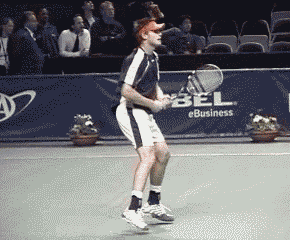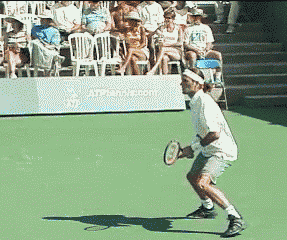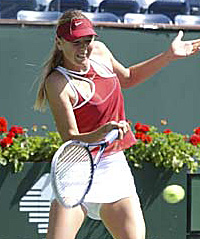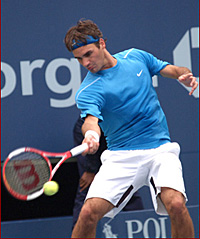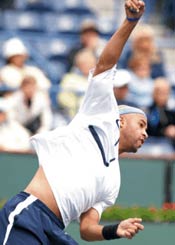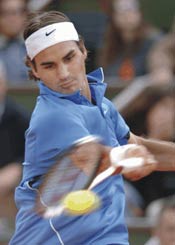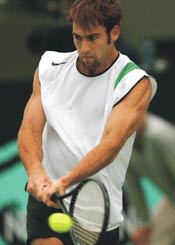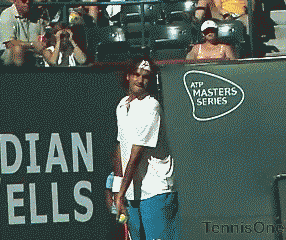|
TennisOne Lessons Back to the Basics Your 10 week Spring Training Program Jim McLennan As we enter 2007, and some of us come to terms with New Years resolutions, I would imagine that few amongst us would not like to play just a little better in the coming months. And if the USTA league is as a big a feature in your life, as it is at our club, then consider that in January, February, and March, we actually have an off-season, to tighten up our games. And much as spring training in baseball is a time when the players refocus on basics, your "spring training," between now and the advent of the next USTA season, can be a time when you step back, evaluate your game, and work diligently on a few things that might just make a difference.
Nearly all of our writers at TennisOne also work as full time teaching professionals. And though the term, "teaching professionals," can mean many things, to my mind our writers are actively involved as teachers and are all life long tennis players with an extensive knowledge of and passion for the game. But equally, their insight is often cutting edge, not just the basic tennis articles in the mainstream press, but rather articles with clearly defined positions, and as often as not, with concepts articulated in ways that challenge how you think of the game, and where you might take your game next. That said, at the same time, it can be that with the volume of material we provide, between Doug King, Dave Smith, Scott Ford, Wayne Elderton, Doug Eng, Dave Kensler, Vic Braden, Heath Waters, Ken DeHart, Happy Bhalla, Rolf Clark, and really so many others, it can be that you (and I) may work a little on this idea, then a little on that idea, without ever really giving any one concept it's just due. That is, the commitment to regular, repetitive, recurring and focused practice.
So more or less like the 10 week program where you develop killer abs, lose all the weight you have accumulated over the past 15 years, or reconfigure your personal "inner" space, consider the following 10 week program to get back to the basics. And commit to a regimen that will have you playing better tennis on April 1st - the beginning of the adult USTA season. Before we begin, and I hope you are with me on this, all that follows are basic tennis ideas, ones that nearly all the ATP and WTA professionals adhere to, but interestingly ones that the better professionals do much more often and the lesser professionals do much less often. And further, as a teacher, I will be creating this same spring training program on court over the next 10 weeks, so what I am writing about will also be occurring in lessons and clinics as I go forward. Overview
Belief Tennis teachers are, for better or worse, simply salesman. They tell you that a particular technique, approach, or tactic will work. And certainly, even the slightest doubt in the student's mind ultimately clouds any reasonable result. If the coach is adamant and convincing, then often the tips tend to work (though sometimes short term gains obscure long term development). So I am hoping to sell what follows. But with a significant proviso. The basics that I ask you to try over the next 10 weeks are also the same ones that the greatest player in the game uses on a routine basis.
What I find interesting is that these basics are so darn obvious yet so little understood that it takes a Roger Federer to show us the way. Roger watches the ball better than anyone else I have ever seen. His point of contact is always way out in front, always and way are both emphasized. And as you progress through this 10 week program, I will use Roger as a guide. People, these are not my ideas but rather my observations. I have seen him do this, and I see many around me who do not do this. Give it a try. Seeing the Ball, the Power of Now, and Embracing the Present. This tennis thing is about so much more than the ball, or so it seems. Strategy, scoring, expectations, good wins, bad losses, closing out matches, dealing with wind are all part of the mix but through it all, the one constant is the ball. And the one element is hitting that ball, one stroke at a time, again, and again, and again.
Sometimes a match hinges on simply which player has more energy and who will focus on the ball, one shot at a time, one stroke at a time, and one point at a time. Over the years only two players stand out to my mind for their ability to really "see this ball." And they are Bjorn Borg and Roger Federer, both riveted their eyes on the ball both as it crossed the net and bounced, but more importantly both riveted their eyes on the ball at the point of contact. Before you do anything else in January, spend as much time as possible on the awareness of your eyes, and on the awareness of your focus. This is not about telling yourself to watch the ball. This is not about a Herculean effort to see the ball. Rather, this is about the awareness of your own attention; where it is, when it varies, about the why and the how. Are you seeing the ball at contact? How about when serving? Are you visualizing the target (perhaps a down the line passing shot) yet still able to keep your eyes down on the ball at contact when threading this needle? Are you aware that your mishits and double faults occur when your eyes wander? Too many times we ascribe complicated reasons for our tennis failures, when it may be nothing more than our inattention to the detail of truly seeing the ball. Point of contact I have a massive tennis library. The newer books tend to be more scientific, biomechanically oriented, and very detailed, whereas the older books were simpler, less technical, and for better or worse much easier to follow. And in nearly every instance the authors advised - "hit the ball out in front." And really not much else.
Grips can be determine the contact point, such that on the forehand a semi western grip moves the contact much further forward than does the continental grip. But at another, and hopefully simpler, level, there is a more solid feel when contacting the ball out in front. And somehow Roger plays the forehand and the backhand way out in front, and all the time, way out in front. Before analyzing your grips, your stance, your tactics, or your shot selection, really get a handle on how often you play the ball out in front. Tension in the face
There is a real meaning to the phrase "up tight." And I believe that tension in any area of the body tends to emanate throughout, so that effortful swings feel much different and generally much worse than effortless swings. But rather than feeling for tension in the grip or in the arms, monitor your face. Do you knit your brow? Do you puff your cheeks? Do you clench your teeth? The masterful Federer is a study in composure as he meets the ball, and this stands in sharp contrast to those who work, those who grimace, and those who appear to be bursting at this moment. So as you now monitor your ability to truly see this ball, again and again, become equally aware of how much or how little effort this takes. The face may be the mirror of the soul, and certainly the same may be true of your tennis strokes, and even your game itself. Are you seeing the ball? Are you meeting the ball out in front? Is your face a study in composure or effort at this moment? Play the entire month with these three prompts. In February we move to the continental grip when volleying and the low eastern forehand from the backcourt. Now hit the practice courts with the following drills. The Service Toss
When serving, notice whether your toss spins, and if so in which direction and how fast. Quite often servers are prone to take their eyes off the ball just before contact, somehow looking down towards the service court prior to the hit. This particular drill creates additional attention on the ball rather than the swing or the target, and is often just the trick to refocus the server on the ball. If this works in practice, try it in a game. And if it works in a game, try it on the big points. If it still is working, you are off to the races. Drop-hit Alley to Alley Drill With practice the goal is to believe you can aim the ball without looking up early, without peeking before impact. Standing on the baseline behind the alley, take 10 forehands (or backhands), keep your eyes down at contact, absolutely no looking up as or before you hit the ball, and see how many balls you can accurately place across the net and into the alley. Practice this drill every time you play this month and see if there is any improvement over time. More importantly, note whether this drill carries over into your games.
Hit and Move, then Look Up Many times, players focus on the opponent a little too soon, looking to anticipate their reply rather than simply finishing the stroke. In this practice drill, stroke the ball, take one recovery step, and then and only then lift your eyes across the net. I am fascinated to see Federer do just this, in many occasions he finishes the stroke, eyes lingering in the contact zone, he takes an initial recovery step, and then and only then does he look up to see what will occur next. Your comments are welcome. Let us know what you think about Jim McLennan's article by emailing us here at TennisOne.
|
|||||||||||||||

